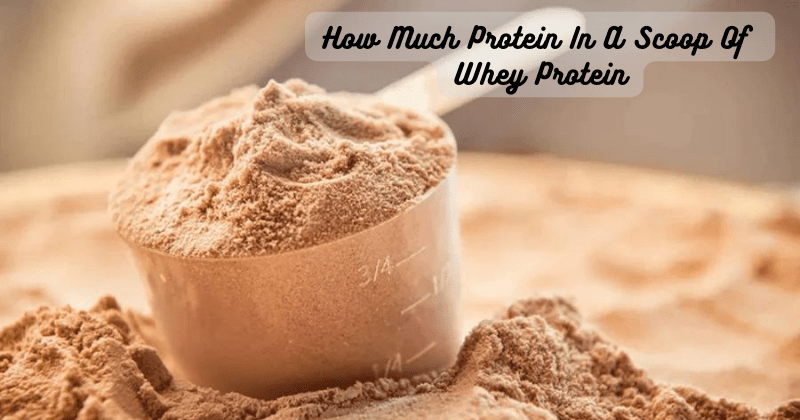Regarding fitness and nutrition, protein is often considered the building block for muscle growth and repair. Understanding the protein content in a scoop is crucial for those who incorporate whey protein into their dietary regimen. The protein content in a scoop of whey protein can vary depending on factors such as brand and serving size. According to my search results, one scoop of whey protein powder typically contains around 20-30 grams of protein.
Protein-packed and convenient, whey protein has become popular among athletes and fitness enthusiasts. Whether you aim to enhance your athletic performance or simply supplement your daily protein intake, knowing the protein content in a scoop of whey protein can help you make informed choices for your fitness goals. In this article, we'll dive into the factors that affect protein content in a scoop of whey protein and how to determine the amount of protein you're consuming.
What Is a Scoop of Protein?
A scoop of whey protein refers to the serving size the manufacturer recommends. This is usually indicated on the product label and can vary from brand to brand. Some brands may use a standard measuring cup as their scoop, while others may provide a specific scoop that measures the correct serving size in grams or ounces. It's important to follow the recommended serving size for the specific brand you're using to track your protein intake accurately.
How much protein is in a scoop of whey protein depends on a few factors, such as the type and quality of whey protein, serving size, and any additional ingredients added to the powder. Essential amino acids, which are the building blocks of protein, can also vary in amount depending on these factors. Three types of whey protein are commonly used: whey protein concentrate, isolate, and hydrolysate. All protein powder supplements contain scooper (a scoop or a tablespoon) and usually indicate how many scoops are needed to get the right amount of protein per serving.
Why Do Scoop Sizes Vary?
As mentioned, the protein content in a scoop of whey protein can vary from brand to brand. This is because different brands may use different types of whey protein and add varying amounts of other ingredients like flavors, sweeteners, and thickeners. For example:
Protein Concentration:
Whey protein concentrate typically contains around 70-80% protein, meaning that the remaining percentage comprises other ingredients such as carbohydrates and fats. This can affect the amount of protein in a scoop, as different brands may use different concentrations of whey protein. Muscle protein synthesis is optimized with whey protein concentrate, making it a popular choice for bodybuilders and athletes.
A 1 kg of whey protein concentrate may contain anywhere from 600-800 grams of protein, which can be divided into different serving sizes depending on the brand. Protein supplements with higher protein concentrations may require smaller scoop sizes to reach the recommended serving size.
Different Brands Have Different Scoops:
Another reason for varying scoop sizes is that different brands may provide their customized scoops. This means that the serving size suggested by one brand may be different from another even though they both contain the same amount of protein per scoop. As mentioned earlier, following the recommended serving size for the specific brand you're using is important.
This information can usually be found on the product label or instructions. Protein powder brands also offer different scoop sizes for different flavors to ensure that the correct number of servings is consumed per container.
How Much Protein In A Scoop Of Whey Protein?
The protein content in a scoop of whey protein can range from 20-30 grams. However, it's important to note that this is just an estimate and may vary depending on the factors mentioned above. To determine the exact amount of protein in a scoop of your specific brand of whey protein, you can check the nutrition label or contact the manufacturer for more information.
Additionally, it's important to consider the serving size and recommended daily protein intake for your fitness goals. For example, if you're aiming to build muscle gain mass, you may need to consume more protein per day compared to someone who is just looking to maintain their current physique. Consult with a nutritionist or healthcare professional for personalized recommendations.
Factors That Influence the Protein Content in a Scoop of Whey Protein
Apart from the type and quality of whey protein used, there are other factors that can affect the protein content in a scoop of whey protein. These include:
Serving Size:
As mentioned earlier, different brands may use different serving sizes for their recommended scoops. It's important to follow the serving size indicated on the product label to accurately track your protein intake. Protein intake is typically measured in grams, so it's important to be aware of the serving size and how many grams of protein it contains. Scoop size can also vary depending on the type of whey protein used.
Additional Ingredients:
Some whey protein powders may contain additional ingredients such as flavors, sweeteners, and thickeners. These can affect the amount of protein in a scoop and should be taken into consideration when calculating your daily protein intake.
Fillers and Additives:
Some brands may also use fillers and additives to increase the volume of their protein powder. These can include ingredients such as maltodextrin, which is a carbohydrate that can help with muscle recovery but does not contribute to protein content. It's important to be aware of these filler ingredients and their potential impact on your overall protein intake.
How To Determine the Amount of Protein You're Consuming
In order to accurately track your protein intake, it's important to know how much protein you're consuming from each scoop of whey protein. To determine this, you can follow these steps:
- Check the nutrition label on the back of the protein powder container.
- Look for the total amount of protein per serving size in grams.
- Divide the total grams of protein by the number of scoops in the container. This will give you the amount of protein per scoop.
- Multiply this number by how many scoops you use in your shake or recipe to get the total amount of protein you're consuming from that particular serving.
- A food weighing machine can also be used for accuracy; just place your scoop on the scale and tare it (set the weight to zero). Then, simply add powder until you reach the desired serving size.
By following these steps, you can accurately track your protein intake and adjust your scoops accordingly to reach your desired daily amount. It's also important to note that while protein powder can be a convenient way to increase your protein intake, whole food sources should still make up the majority of your protein consumption.
FAQs
Is it OK to take two scoops of whey protein a day?
This depends on your individual protein needs and fitness goals. It's always best to consult with a healthcare professional or nutritionist for personalized recommendations.
What is the best time to take whey protein?
The best time to take whey protein can vary depending on personal preference and fitness goals. Some people prefer to take it in the morning, before or after a workout, and/or as a snack throughout the day. Consuming protein within 30 minutes of exercise is important for optimal muscle recovery.
How long does 1 kg of whey protein last?
This can also vary depending on individual protein needs. If consuming one scoop per day, 1kg of whey protein could last approximately 30-40 days. However, if you are consuming multiple scoops per day or using the protein powder in recipes, it may not last as long.
How many eggs equal one scoop of protein powder?
One scoop of protein powder is equivalent to about 3-4 large eggs in terms of protein content. It's important to consider the other nutritional differences between these sources, such as fat and cholesterol content.
Conclusion
In conclusion, the protein content in a scoop of whey protein can vary depending on factors such as brand and serving size. Based on multiple sources I found during my search, one scoop of whey protein powder typically contains around 20-30 grams of protein. However, it's important to note that some sources mentioned different values, such as 25 or 30 grams. This discrepancy could be due to variations in the type of whey protein or different measuring methods used.
Regardless of the exact protein content, incorporating whey protein into your diet can provide significant benefits, especially for those looking to support muscle growth and recovery. It is a convenient and effective way to supplement your daily protein intake, particularly for athletes and fitness enthusiasts. Additionally, whey protein is often low in fat and carbohydrates, making it an attractive option for those watching their calorie intake or following specific dietary restrictions.
Understanding the protein content in a scoop of whey protein allows you to make informed decisions about your protein consumption, helping you reach your fitness goals and maintain a balanced diet.


